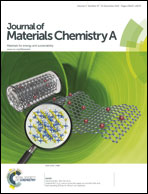Magnetically driven Bi2O3/BiOCl-based hybrid microrobots for photocatalytic water remediation†
Abstract
In this work, we have developed 3D hybrid microstructures consisting of a short ferromagnetic CoNi segment for wireless magnetic control, coupled to a photocatalytic Bi2O3/BiOCl segment for water remediation under UV-visible light. These hybrid microstructures (pillars and helices) were fabricated using 3D photolithography and template-assisted electrodeposition, followed by in situ creation of a Bi2O3/BiOCl heterojunction after oxidation of Bi. This heterojunction is not only active under a wider solar spectrum but also ensures sufficient charge separation and hence low electron–hole recombination rate. As a result, these hybrid microstructures were able to degrade rhodamine B dye with a 90% efficiency in 6 hours. On application of magnetic fields we were able to precisely control the structures and collect them for reuse. Cytotoxicity tests were performed on our hybrid structures and a 95% cell viability was reported showing that our structures are biocompatible.


 Please wait while we load your content...
Please wait while we load your content...